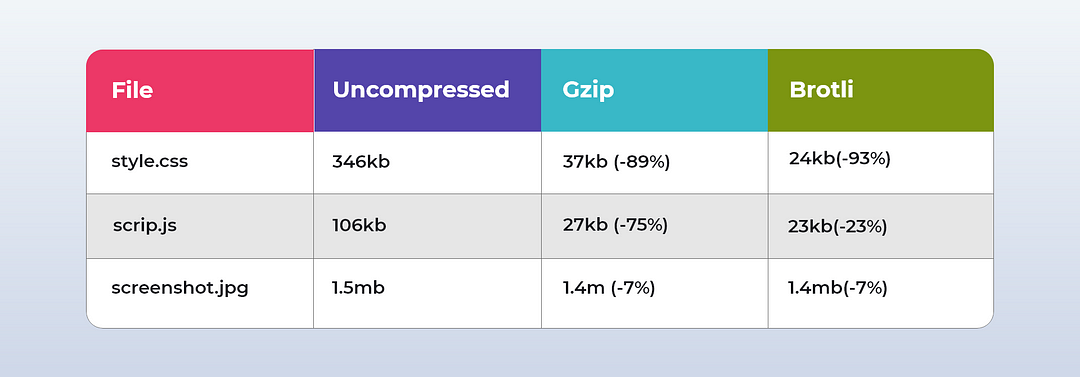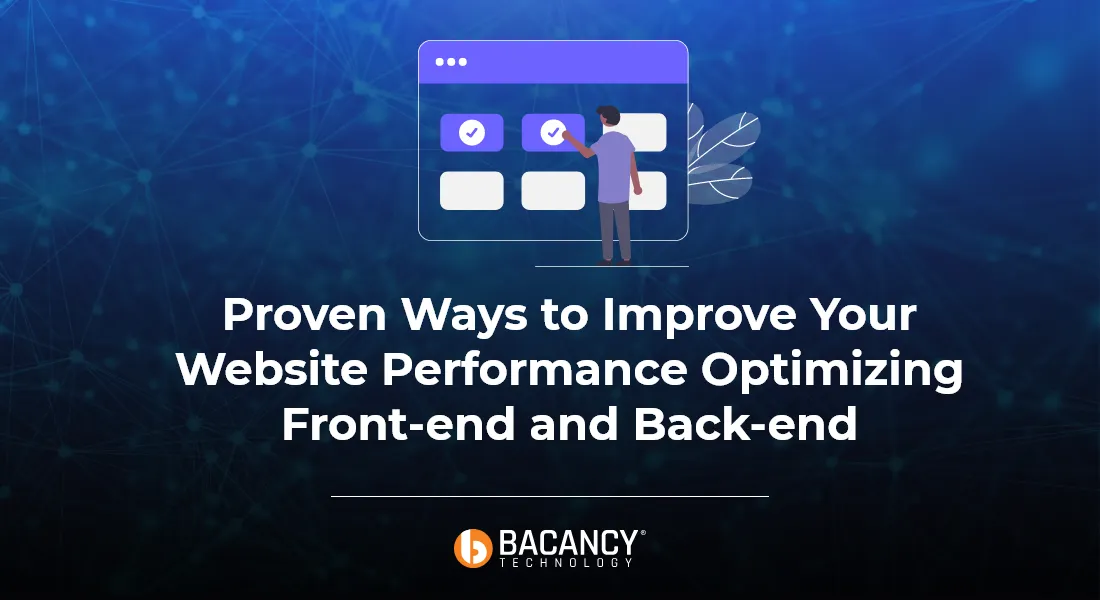Quick Summary:
In today’s tech world, numerous websites are accessed every day for various reasons. Unfortunately, sometimes you may face challenges on the website that are clunky and bothersome to use. The poorly optimized websites may contain multiple issues and errors, including browser incompatibilities, slow loading time, etc. But we think that there may be some back-end issues that affect the website performance, but have you ever wondered if front-end issues may also slow down your performance. In this blog, we’re going to know about the useful techniques you can use to improve your website performance, be it front-end or back-end.
Introduction
Before we start to optimize your website’s performance, it’s essential to set a goal for where you want it to be. That can be difficult for you if you’re not aware of what acceptable page speed is.
As per the Google’s latest guidelines, the faster your website loads, the higher the chances are to achieve favourble results, and improve your conversion rate.
That’s the main reason why website optimization is the most crucial aspect for any website owner. Here we’re going to measure your website performance and the tips that help increase website loading speed by optimizing your website’s back-end and front-end because front-end issues are equally important as back-end.
So, let’s get started!
Facing Website Performance Issues?
A website with good performance represents a brand and its image. It is essential to keep an eye on your website performance as it doesn’t take much time to have a better UI/UX. Every user expects their website to be best and fast.
Sometimes, the website does not work correctly, and you face issues that may impact your business and your activities. Out of 20, 17 digital product owners believe that there might be back-end issues that cause trouble to the website performance. Well, they are undoubtedly right. Almost 60% to 70% is the possibility that there could be Back-end issues. However, when it comes to improve your website performance, do you know it could be slow down because of a front-end issue as well? Some of you will agree, whereas some of you won’t.
According to Steve Souders, 80% of the average page load times occur after the markup is completely downloaded. For your users, a 50% speedup in your front-end code is going to mean a lot more to them than a 50% speedup in your back-end code.
Common website performance issues (Back-end only)
- The N+! Query Problem
- Database optimization
- Server and Browser Caching
- Web Hosting Solutions
- Content Delivery Network (CDN)
Only Back-end Issues? What if There are Front-end Issues Which are Affecting your Website Performance.
The back-end issues, as mentioned above, are not the ones that can hamper. There could be front-end issues as well. Because of these common front-end issues, people won’t even give your application a second thought if it is not visually appealing. Nobody will care if your back-end is fast if your front-end is not convincing. Moreover, solving front-end issues won’t be that much more critical than it is in the back-end. So, let’s have a look at common front-end issues.
- Lazy loading
- Large size images
- Unused CSS
- Brotli and Gzip Compression
These are the common front-end issues people come across, and that hampers the website performance for sure.
Now, you might be wondering. We already know these common issues, and some of you might know how to solve them as well. But let me tell you that there is always a learning curve. Let’s educate each other about the issues and how to get rid of them with better solutions.
You must be wondering if there is any one-stop solution that can solve back end and front-end problems both. And guess what? A full-stack web developer is a one-stop solution and knows how to get rid of them with better solutions.
A full-stack web developer can be a one-stop solution to solve the front-end as well as back-end issues.
What is a Full Stack Developer?
To put it in a nutshell, a full stack developer meaning a well-versed programmer who has the expertise of both ends to offer a smooth user experience: front-end and back-end development.A full-stack developer can jump from one part of the application to another without significant overload. This is a huge advantage when planning forward or when designing new features. That’s why more and more developer wants to become a full-stack developer in 2020.
A full-stack developer can efficiently work on both front-end and back-end technologies like;
**Front-end: Angular, Vue, and React **
**Back-end: ROR, Laravel, .NET, PHP, Python, Golang, and many more. **
A full-stack developer is the one who is well-versed with more than one technology in a project and came up with great solutions no matter what scale of application it is.
How a Full-stack Developer Can Help You Solve Back-end Issues
1. The N+1 Query Problem
The N+1 query intricacy frequently happens when any queries are assigned to associated fields in your database instead of printing one compound SQL query, including all the reports which are to be regained. Using eager loading, all associated questions are requested with a single entity instead of multiple queries that may slow down your application’s performance.
2.Database Optimization
Database optimization plays a significantly vital role in improving your website performance. Sometimes unoptimized databases may slow down your performance and denormalize your database.
*** Normalizing a Database**
Normalizing your database is a logical outcome when designing a relational database, but some developers still decline this process at times. Optimizing databases reduces the amount of space that a database requires and organizes your data to improve website performance.
*** Database Indexes**
A common issue that slows down your website’s performance is database indexes. If database indexes aren’t used properly or are not used properly, then the website performance may slow down. Database indexes serve the same purpose as indexes in a book; every index element has the required object’s name and an identifier showing its location. The primary purpose of creating database indexes is to search for matching data instead of going through all the searches in the database.
*** Database Denormalization**
It is a speculative correction of any normalized database, so it doesn’t give up standard forms. Denormalization reduces the time required to select queries and adds redundant data into existing tables to make it more accessible.
3.Server and browser caching
In computing, caching is the process of storing data and reloading it so that future requests for that data can be served faster, and the web page isn’t rendered repeatedly for each user. Caching allows users to work with the bulk of data quickly while using minimal server resources to be implemented on the client and server-side.
*** Fragment Caching**
Fragment caching typically refers to boundless caching. Your website’s web pages are cached using fragment caching for dynamic web applications that may quickly become irrelevant. Complex web apps contain many blocks and components, so it needs to be re-rendered when any modifications are done to the web pages.
*** Page Caching and Action Caching**
Page caching is the most effective and widely used caching for performance optimization, which is wholly implemented on the webserver. After executing on the web server, it returns cached static content to your application. But in some cases, page caching is not suitable for applications having frequent results that would produce content a user has seen before.
Caching enhances your website performance by diminishing the load time and server load time because every cached web page can be conveyed to users’ multiple times.
4.Web hosting service
Web hosting services are for backups and server management. It helps to improve your website performance depending on the web hosting service and web hosts with various capabilities and scalability options. Compared to all web hosting, shared web hosting is the most popular, widely used, and popular web hosting.
Here we’re going to cover VPS, cloud hosting, and dedicated hosting that plays a significant role in performance optimization, and it has enough capabilities to improve your website performance.
*** Virtual Private Servers**
A low-cost shared web hosting package and costly dedicated hosting connect the VPS that extends a personal virtual server for a specific client and configures shared hosting considering your configurations don’t affect other clients.
The prices of VPS are affordable, but it may go up if your website requires some additional services. It is an optimal solution for your website, having average traffic that expects traffic spikes during specific periods.
*** Cloud Hosting**
Cloud hosting is suitable for small and medium businesses implementing applications with uncertain traffic for eCommerce websites. Computing resources becomes easy if you’re using cloud services and pay only for what you use. Therefore, with cloud hosting, you’re not required to pay for resources that your website doesn’t use.
*** Dedicated Hosting**
Dedicated hosting offers you a dedicated server that pertains only to you, which is an unreasonable solution. First, you’re obligated to pay the server rent, which is $150 per month. Secondly, you should have a system administrator that can manage your server. This way, with dedicated hosting, you get all the power and resources that you need from the operating system to the type of memory where security and speed are critical.
5. Content Delivery Network (CDN)
Content delivery network, commonly referred to as CDN, is a distributed proxy server called “edge servers.” its functionality helps you cache static content such as CSS files, JavaScript, and images, which is also dynamic cache content.
It helps to improve your website performance, enhancing page load speed and performance on its server’s location to decrease your performance.
Reduced Costs
CDN allows users to retrieve requested content faster. Imagine that any user from the USA is trying to retrieve content from a server-based India. If your website is working great and gaining popularity, it is proof that more people will access it. Do you think these issues might have caused your website performance in the past? If yes, then not to worry, you will get solutions for these back-end issues once you complete this blog.
What are the solutions for front-end issues?
1. Lazy Loading
When you request to load a web page, the browser requests for its images, overlooking other things like whether they’re in the viewport or out of sight. With lazy loading, all the visible images and asynchronous load the rest on-demand when the user scrolls. It helps you to improve your website performance, reducing the loading request.

Lazy Loading medium Lazy loading was implemented with the Intersection Observer API in 2019. The exceptionally well-written tutorial was implemented by Google showing the importance of lazy loading, which you should check out if it’s something you’re looking for.
2. Responsive Images
It is another significant way to reduce your website’s page size for the better use of viewport space. To show the appropriate image size depending on the viewport size, implement the srcset and sizes attributes like:
< picture >
< source media=“(max-width: 799px)” srcset=“dog-480w.jpg” > < source media=“(min-width: 800px)” srcset=“dog-800w.jpg” >
< img src=“dog-800w.jpg” alt=“A picture of a dog” > < /picture >
3. Remove Unused CSS
In modern front-end development, Bootstrap is a suite of highly reusable classes for creating quicker and more responsive UI creation.
Here is the example showing a typical grid system implemented using Bootstrap:

All the classes shown in the following example create columns with full-width and generate a classic 3-column layout. It is generated in SASS file-based on the breakpoint variables provided to Bootstrap.
Quick Read:
03 Best Full-Stack Combinations (Front-end + Back-end Pairs That Can DO Wonders)
4. Brotli and gzip Compression
With the help of compression devices like gzip and Google’s Brotli, it is so convenient to decrease the file sizes requests:

When you compare the CSS and JS files, you’ll notice that the PNG’s compression ratio is pretty dull. Gzip and Brotli are perfectly suited for text-based files where the repetition rate is pretty higher for the compression to be more successful.
Top Front-end web development and Back-end Web Development Tools 2020
Best front end tools in web development are:
- React, Vue, or Angular (UI frameworks)
- Gatsby, Ruby on Rails, or NodeJS (Web framework)
- Babel or TypeScript (Compiler)
- Webpack, Rollup, or Parcel (Bundlers)
- Sass, Bourbon, or PostCSS (CSS tools)
Best back end tools in web development are:
- AWS EC2 (Cloud Servers)
- AWS Lambda or AWS S3 (Serverless Services)
- MongoDB or PostgreSQL (NoSQL Databases)
- Languages like Python or Javascript via NodeJS
- Serverless Framework (web application framework)
Not only this, but a full stack web developer can also help you with other tools and technologies to improve your website performance and scale up your business.
If you have cross-platform applications built-in Flutter, React Native, Ios, Android, Ionic, they are well-versed enough to help you with 360-degree solutions.
Conclusion:
Currently, a typical user expects web pages to load less than after 3 seconds. If you don’t meet this expectation barrier, you lose a lot of website traffic and, as a result, your revenue.
So, website performance is the most important concern for any digital product owner who has to look into it frequently, regardless of its size. Nobody likes a slow website. So, I hope your purpose of landing on this blogpost is served, and you got a better understanding of why you should hire full stack developer or a team to improve your website performance. Full-stack developers are the ones who are well-versed and skilled enough in offering top-class solutions for both front-end as well as back-end issues.
#improve #websiteperformance #front-end #back-end #optimization #fullstackdevelopment
